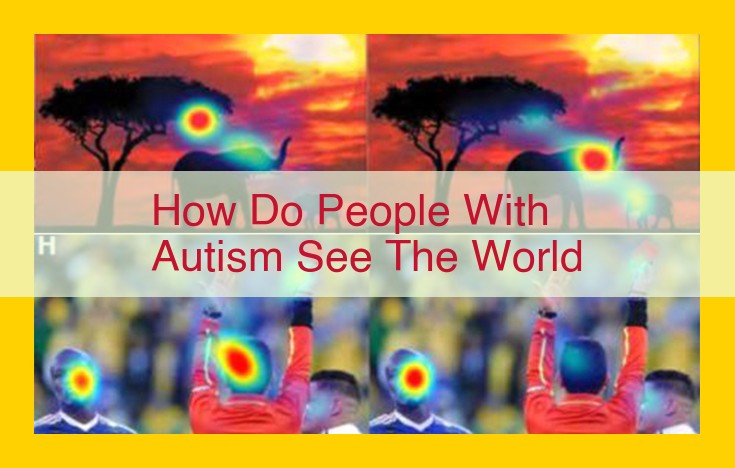Individuals with autism spectrum disorder (ASD) perceive the world differently due to neurological and cognitive variations. Altered neuronal connectivity and sensory processing impact executive function. Social challenges stem from difficulties with social cognition, theory of mind, and empathy. Sensory differences include hyper- or hypo-sensitivity to stimuli, with unique visual, auditory, and olfactory processing patterns.
Neurological and Cognitive Foundations of Autism Spectrum Disorder (ASD)
ASD, a complex neurodevelopmental condition, is characterized by a distinct array of core neurological features that significantly impact cognitive function.
At its core, altered neuronal connectivity in ASD disrupts the typical flow of information between brain regions, affecting neural communication and processing. Synaptic plasticity, the brain’s ability to adapt and reorganize connections, is also atypical in ASD, interfering with learning and memory.
Furthermore, sensory processing is often disrupted in ASD. Individuals may exhibit hyper- or hypo-sensitivity to specific stimuli, creating a heightened or diminished response to sensory inputs like light, sound, or touch. This can lead to sensory overload or underload, which can challenge engagement with the environment.
The interplay of these neurological characteristics profoundly influences cognitive functioning in ASD. Executive functions, encompassing skills such as planning, impulse control, and working memory, are frequently affected. Difficulties in these areas can impact daily life, from managing routines to navigating social interactions.
Social and Emotional Attributes Associated with ASD
Autism Spectrum Disorder (ASD) presents a unique set of social and emotional challenges stemming from cognitive and neurological differences. Individuals with ASD exhibit difficulty in understanding social cues, interpreting others’ intentions, and expressing emotions appropriately.
Understanding Social Cognition in ASD
Social cognition refers to our ability to process social information, such as recognizing facial expressions, understanding body language, and interpreting tone of voice. In ASD, atypical neuronal connectivity and altered synaptic plasticity affect the brain regions responsible for these processes, resulting in difficulties with:
- Recognizing facial expressions: Individuals with ASD may struggle to interpret the emotions conveyed by facial expressions, leading to challenges in understanding social cues.
- Understanding body language: Nonverbal communication, such as gestures and posture, provides valuable social information. However, individuals with ASD may have difficulty interpreting these cues, affecting their ability to respond appropriately.
- Interpreting tone of voice: The emotional undertones conveyed through speech can be difficult for individuals with ASD to understand, hindering their communication and social interactions.
Theory of Mind: A Window into Others’ Thoughts
Theory of mind refers to our ability to understand that others have their own beliefs, desires, and intentions, even if they differ from our own. This cognitive ability is often impaired in ASD, resulting in difficulties with:
- Understanding others’ perspectives: Individuals with ASD may struggle to recognize that others have different thoughts and feelings, which can lead to misunderstandings in social interactions.
- Predicting others’ behaviors: By understanding others’ intentions, we can anticipate their actions. However, impaired theory of mind affects this ability in ASD, making it challenging to navigate social situations effectively.
Empathy: Connecting with Others’ Emotions
Empathy involves our ability to understand and share the emotions of others. Individuals with ASD may experience atypical emotional responses, such as limited facial expressions, reduced eye contact, and difficulties in emotional regulation. These challenges hinder their ability to:
- Recognizing others’ emotions: The ability to identify the emotions expressed by others is crucial for empathy. However, impaired social cognition and emotional processing can affect this ability in ASD.
- Feeling connected to others: Empathy fosters social bonds by allowing us to relate to others on an emotional level. Difficulties in understanding and expressing emotions can limit this connection in individuals with ASD.
Sensory and Perceptual Differences in Autism Spectrum Disorder (ASD)
Individuals with autism spectrum disorder (ASD) often experience the world differently than neurotypical individuals. Their brains may process sensory stimuli in a unique way, leading to atypical sensory experiences.
Hyper- and Hypo-Sensitivity
One common sensory difference in ASD is hyper- or hypo-sensitivity to various stimuli. This means that individuals with ASD may be either overly sensitive or under-sensitive to certain inputs. For example, some may be hypersensitive to loud noises or bright lights, while others may be hyposensitive to pain or temperature.
Unique Processing Patterns
In addition to sensitivity differences, individuals with ASD may also have unique visual, auditory, and olfactory processing patterns. For instance, they may perceive visual information differently, resulting in difficulty with spatial reasoning or eye contact. They may also experience auditory sensitivities, such as difficulty understanding speech in noisy environments or finding certain sounds irritating. Furthermore, olfactory processing may be affected, leading to heightened sensitivity to certain scents or an inability to detect others.
Impact on Daily Life
These atypical sensory experiences can have a significant impact on daily life for individuals with ASD. Sensory sensitivities can make it challenging to participate in social situations, navigate crowded environments, or focus on tasks that require sustained attention. They may also lead to anxiety, frustration, and avoidance behaviors.
Understanding Sensory Differences
It is important to understand and respect the sensory differences experienced by individuals with ASD. By creating sensory-friendly environments and providing accommodations, we can help them live more comfortable and fulfilling lives.
